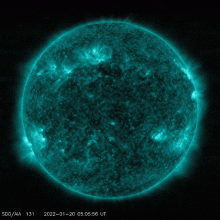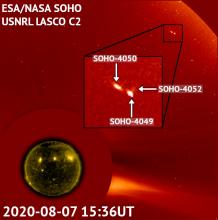Listen to today's episode of StarDate on the web the same day it airs in high-quality streaming audio without any extra ads or announcements. Choose a $8 one-month pass, or listen every day for a year for just $30.
You are here
Windy Sun
[SFX: solar sounds] That’s the sound of a gusty breeze. It’s not blowing across the Great Plains or some other icy domain, though. Instead, it’s blowing throughout the solar system — a million-mile-an-hour wind from the Sun.
The solar wind is a flow of electrons — the bits of atoms that have a negative electric charge. They’re shot out into space by the Sun’s magnetic field. The details of how that happens are still elusive, though.
The solar wind is always blowing. At times, though, it gets stronger — and gustier. That’s the result of magnetic storms on the Sun or in its outer atmosphere. As they’re kicked outward, the electrons produce radio waves. Receivers on Earth “hear” those waves.
As the solar wind reaches Earth, it collides with our planet’s own magnetic field. And when the solar wind is especially strong, the contact creates magnetic waves in the field’s outer regions. A group of European spacecraft recorded the waves from several of these encounters. Scientists recently converted the waves to sound.
The magnetic waves travel all the way to the surface. Scientists are trying to understand how that happens — and what it means for the interaction between Earth and the solar wind — a constantly changing breeze from the Sun.
We’ll hear more from the Sun tomorrow.






